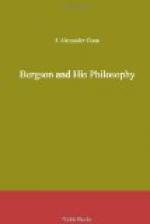motion the body in whole or in part. When we make
enquiries from the physiologist or the psychologist
with regard to the origin of these images and representations,
we are sometimes told that, as the centrifugal movements
of the nervous system can evoke movement of the body,
so the centripetal movements—at least some
of them—give rise to the representation,
mental picture, or perception of the external world.
Yet we must remember that the brain, the nerves, and
the disturbance of the nerves are, after all, only
images among others. So it is absurd to state
that one image, say the brain, begets the others, for
“the brain is part of the material world, but
the material world is not part of the brain.
Eliminate the image which bears the name ‘material
world,’ and you destroy, at the same time, the
brain and the cerebral disturbances which are parts
of it. Suppose, on the contrary, that these two
images, the brain and the cerebral disturbance, vanish;
ex hypothesi you efface only these, that is to say,
very little—an insignificant detail from
an immense picture—the picture in its totality,
that is to say, the whole universe remains. To
make of the brain the condition on which the whole
image depends is a contradiction in terms, since the
brain is, by hypothesis, a part of this image."[Footnote:
Matter and Memory, p. 4 (Fr. pp. 3-4).] The data of
perception are external images, then my body, and
changes brought about by my body in the surrounding
images. The external images transmit movement
to my body, it gives back movement to them. My
body or part of my body, i.e., my brain, could
not beget a whole or part of my representation of
the external world. “You may say that my
body is matter or that it is an image—the
word is of no importance. If it is matter, it
is a part of the material world, and the material
world consequently exists around it and without it.
If it is an image—that image can give but
what has been put into it, and since it is, by hypothesis,
the image of my body only, it would be absurd to expect
to get from it that of the whole universe. My
body, an object destined to move other objects, is
then a centre of action; it cannot give birth to a
representation."[Footnote: Matter and Memory,
p. 5 (Fr. p. 4).] The body, however, is privileged,
since it appears to choose within certain limits certain
reactions from possible ones. It exercises a
real influence on other images, deciding which step
to take among several which may be possible.
It judges which course is advantageous or dangerous
to itself, by the nature of the images which reach
it. The objects which surround my body reflect
its possible action upon them. All our perception
has reference, primarily, to action, not to speculation.[Footnote:
Cf. Creative Evolution, p. 313 (Fr. p. 321).]
The brain centres are concerned with motor reaction
rather than with conscious perception, “the
brain is an instrument of action and not of representation."[Footnote:




